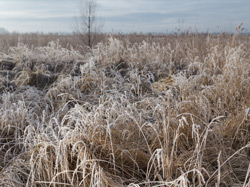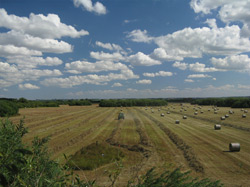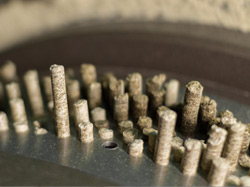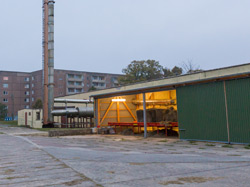Canary grass (Phalaris arundinacea)
In brief
Reed canary grass (Phalaris arundinacea) forms dominant stands on moist, base-rich fens with good nutrient and oxygen supply from groundwater or regular flooding. It is also naturally found on mineral soil sites.
The peat formation capability of reed canary grass is still unknown. Therefore, reed canary grass in paludiculture is only peat-preserving. This grass resembles reeds and reaches a height of 0.5-2 m. It spreads by seeds and rhizomes. In suitable site conditions it is long-lived and highly productive.
Water level: 0-20 cm below ground level, in winter above ground (water level: 4+/5+)
Establishment: Seeding or natural spreading after raising water levels
Yield: 4-10 t dry matter per hectare per year
Harvest: Annually or biannually.
Utilization: Energy biomass (fuel, substrate for biogas plants), fodder, bedding
Emission reduction: Approx. 19 t CO2 eq. per hectare per year (compared to nutrient-rich, drained fens, not including emission reduction through the replacement of fossil fuel based raw materials).
Potential
In Germany, more than 1.2 million hectares (99%) of peatland soils are degraded. Even if only 10% of drained peatlands were rewetted and planted with reed canary grass in paludiculture, 480,000 t of biomass could be harvested annually with a gross fuel yield of almost 8 million GJ at a productivity of 4 t dry matter per hectare per year. This amount is sufficient to supply fuel to approximately 400 local heating plants (800 kW).
Establishment

Reed canary grass is seeded in spring to late summer. Per hectare, 15-25 kg of seed is placed 1-2 cm deep at a row spacing of 12.5 cm. Water level should be below ground during establishment. Three years after seeding the stand reaches full productivity. Reed canary grass can also spontaneously form dominant stands after rewetting through succession since it occurs as a companion plant in many areas.
Water management and nutrient supply
Reed canary grass prefers moist sites and a summer water table of 0-20 cm below ground level. High productivity is achieved with regular overflow or with an oxygen-rich groundwater supply. During prolonged periods of above-ground water in summer, the stands are replaced by reeds or sedges. Nutrient replenishment occurs predominantly from flooding or, in the case of non-waterlogged soils, via site-appropriate mineral or organic fertilization.
Maintenance
Taking water levels into account, adapted meadow plowing is recommended (rolling, dragging), but the water level should not be lowered in spring. Reed canary grass stands cannot withstand trampling and therefore are only conditionally suitable for intensive grazing, which must be done with great care.
Harvest & Yield

Harvesting
Depending on the utilization, reed canary grass can be harvested annually in summer as hay or silage. Harvesting can also be delayed until November/December for improved fuel properties. However, late season harvesting is more difficult because stands often collapse, material is difficult to dry, and higher water levels require the use of specialized equipment.
In summer, harvesting is done with adapted grassland technology (twin tires or wide tires with compressed air control). Depending on the utilization and groundwater level, single- or multiple-stage methods for harvesting and clearing can be considered. In multi-stage methods, cutting, any baling, and removal are divided into individual operations. The cutting height for mowing should be at least 10 cm.
Harvesting costs with adapted grassland technology up to the edge of the field (including mowing, turning, windrowing, baling, salvaging) are about 210 euros per hectare for a yield of 4 t dry matter per hectare.
Yield
The yield of reed canary grass depends on harvesting time, water level, and nutrient availability, and ranges from 4 to 10 t dry matter per hectare per year.
With sufficient nutrient supply, high yields can be expected in the long term. Failure to supply nutrients can lead to scouring and the spread of sedges.
Utilization

Utilization as fodder
If reed canary grass is harvested and ensiled before flowering, the energy content ranges from 4.5-7.1 MJ NEL per kg. Use as ruminant feed is possible. Reed canary grass hay harvested in late summer can be used as horse feed.
Utilization as energy biomass
Reed canary grass can be burned as a loose fuel or in a refined form as pellets and briquettes. The biomass has a calorific value of 16.9 MJ per kg and an ash content of 2 - 6%. The ash melting point when harvested late is between 1100 - 1200°C. Late or winter harvested reed canary grass has better fuel properties than when it is harvested early. Like cereal straw, the fuel properties of reed canary grass hay can be improved by allowing the cuttings to remain on the land longer. Rain can then leach out the components that hamper combustion.
With summer mowing and ensiling, reed canary grass can be used as a co-substrate in biogas plants. Biogas yields depend on the plant and pre-digestion and are comparable to those of green waste.
Implementation

Status of implementation
Reed canary grass is an established fodder and a useful plant in animal husbandry (silage, hay, bedding). It has also been adapted for energy production in Scandinavia.
The Malchin biomass heating plant has been successfully burning reed canary grass and sedge hay from rewetted fens in the Peene Valley (Mecklenburg-Vorpommern, Germany) since 2014 and supplies 540 households, two kindergartens, a school, and other public buildings with heat. The heating plant is operated by Agrotherm GmbH.
Challenges and obstacles
Since there is no financial compensation for bioheat, heat from renewable solid fuels is in direct competition with natural gas.
For the use of refined fuels from reed canary grass (pellets and briquettes), an approved combustion plant is required with a firing capacity below 100 kW. For plants above 100 kW, a permit is required.
Sources & further information
- Heizwerk Malchin: www.niedermoor-nutzen.de
- Dahms, T. et al. 2017: Halmgutartige Festbrennstoffe aus nassen Mooren. Universität Greifswald
- Schröder, C., Schulze, P., Luthard, V. & Zeitz, J. 2015: DSS-TORBOS Steckbriefe für Niedermoor-
bewirtschaftung bei unterschiedlichen Wasserverhältnissen: www.dss-torbos.de - Wichtmann, W., Schröder, C. & Joosten, H. (Hrsg.) 2016: Paludikultur – Bewirtschaftung nasser Moore.
Schweizerbart, Stuttgart, 272 Seiten - Flyer "Steckbrief Rohrglanzgras"











